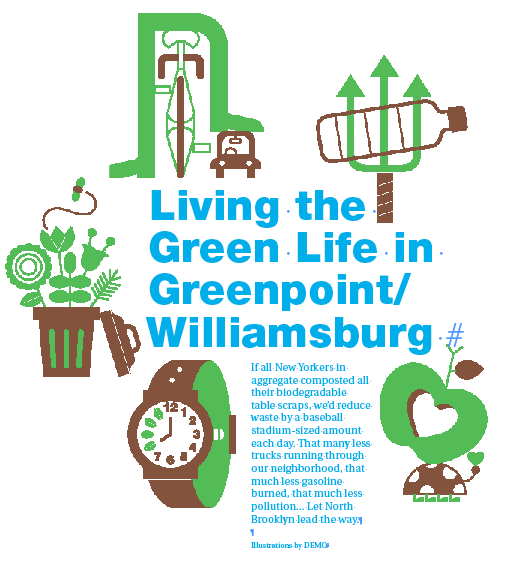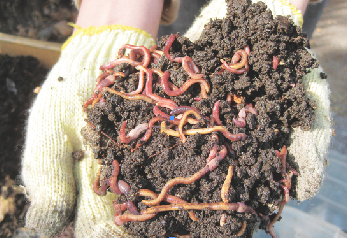
By Lisette Johnson
Of the 250 million tons of trash generated by Americans in 2008, only 83 million of it was recycled or composted. Yard trimmings and food scraps—stuff farmers have used to enrich their fields for generations—constituted over 25 percent of municipal solid waste nationwide in the same year. The idea of recycling has become ubiquitous to most New Yorkers; fines are issued for failure to comply and public recycling bins are starting to pop up around the City. And though New Yorkers can count themselves as some of the most Earth-conscious urbanites on the planet (New Yorkers statistically have some of the tiniest carbon footprints in America), most of us do not compost.
The effects of eight million people not composting are compounded by the fact that, according to Kate Zidar, founder of the North Brooklyn Compost Project, New York is the largest waste-exporting state in the country. Before the Fresh Kills Landfill on Staten Island closed in 2001, it was the largest landfill in the world, taking in roughly 13,000 tons of garbage every day. Since then, most of the City’s waste has been shipped to remote landfills as far as Pennsylvania and Virginia. Throwing away food scraps, then, contributes not only to the pollution caused by greenhouse gases emitted by landfills, but also to emissions from the trucks.
Yet for Zidar, composting is about more than saving the planet. Reducing her personal contribution to the garbage system is a primary motivation, but so is the prospect of running a cleaner kitchen. “To me, putting my food scraps in the garbage is gross,” she says, in part because rats and vermin are attracted to it. “My garbage doesn’t stink. I don’t have a concern for pests in the kitchen. The traditional way of handling food waste provides a basic support for the rat and roach population in New York,” she says.

Red Wiggler worms, the magic ingredient in composting. Photo by Lisette Johnson
Zidar founded the North Brooklyn Compost Project in 2004. Every Saturday, from spring until October, Zidar and project volunteers collect organic waste from North Brooklyn residents in a small corner of McCarren Park. There are about ten large rat-proof compost bins, constructed by members. “The overarching goal, the idea of the drop-off bins, is to get people in the habit of not putting their food waste in the garbage,” says Zidar. The project shows people how minimal the work is to participate, and that composting is far from a rotten process. October 30th marked the last day of drop-off operations for 2010, but for Zidar, and compost-conscious Brooklynites, the days of pest-free kitchens aren’t over. The best bet for winter composting, which Zidar demonstrated on the 30th, is vermicomposting, an indoor-friendly composting process carried out in the bellies of red worms.
It’s easy to set up a vermicompost system in a Brooklyn apartment, regardless of how tiny your kitchen is. It’s made for speedy breakdown of organic waste, and for compact living. You’ll first need a ventilated container. The Lower East Side Ecology Center (LESEC) sells tubs especially for the process, which cost $55, including worms. A standard waterproof storage bin will work as well. You’ll need to poke large holes (with screens) at the top, and small holes in the bottom for drainage. “The worms don’t like it when it’s too wet in their house,” says Zidar. She has hers in a milk crate lined with newspaper that soaks up any of the drainage, which is, again, minimal. There’s no need to worry about messing up your kitchen with compost run-off while operating a vermicompost system.
The first step is to add brown matter to the bin. Brown matter is rich in carbon and serves as food for bacteria. For urban composting, newspaper scraps (from newspapers, not glossy magazines) are the most common and simple form of brown matter. Food scraps are considered green matter, which is full of moisture-rich nitrogen. The trick is to add brown mater whenever you add green. If the bin starts to get full, push all the compost to one side, and fill the vacant side with brown matter to start again. Successful composting is all about keeping the carbon and nitrogen ratios relatively even.
The magic ingredient is the worms. They work so quickly that the compost will not need to be harvested (the bin will not need to be emptied) for anywhere from six to nine months. Zidar rather likes the idea of keeping such strange pets, though they never leave her composting system. Composting occurs in the gut tubes of the worms, which manage to pack away half their bodyweight in food every day. The three factors that can negatively affect these strange pets are heat, flooding, and acidity. Worms can be obtained from the LESEC, or harvested (as they were on the 30th) from last year’s compost. They can also be bought at bait shops in or just outside the City. And, of course, they can be found on sidewalks after a heavy autumn rain.
If keeping worms in your kitchen isn’t your thing—even though it’s sanitary and both pest- and pet-resistant—and you want to compost anyway, there are other ways to do it. If you’re in the habit of freezing or keeping food scraps and dropping them off, and want to continue doing so, your best bet is to take them to the Lower East Side Ecology Center drop-off. Founded in 1987, the LESEC runs a community compost drop-off at the Union Square Greenmarket every Monday, Wednesday, Friday, and Saturday all year long. Aurelia Kaelin, who works the stand, says that every day about ten new people drop off their organic waste. “Maybe five of those new people adopt the habit,” she says.
According to a LESEC survey, in 2009 about 1,000 households were dropping off compost at Union Square, but this year the number spiked to 1,500 households per week. The organization collects roughly four tons of food scraps per week, and though most of the people who drop off live in the Union Square or East Village areas, there are participants from all five boroughs (the second highest number of people are coming from Brooklyn), New Jersey, and Connecticut.
If trekking last night’s dinner to Manhattan doesn’t interest most Brooklynites, there are yet more options. Over 20 organizations and community gardens operate compost drop-offs, in all areas of Brooklyn. Some, like the NBCP, are seasonal, but many are in operation whenever the garden is open. The 6th Avenue and 15th Street Community Garden in Park Slope is one such location, and is currently developing a 24?/?7 drop-off program. The garden will be accepting yard trimmings every weekend in November. To find a program that’s convenient for you, check out the NYC Compost Project (via the “Composting in NYC” tab on nyc.gov/wasteless), which has links and contact information for programs in every borough. Two in the Williamsburg/Greenpoint vicinity worth checking out are the Bushwick City Farm and Earth Matter Bushwick Composting.
Leave a Reply